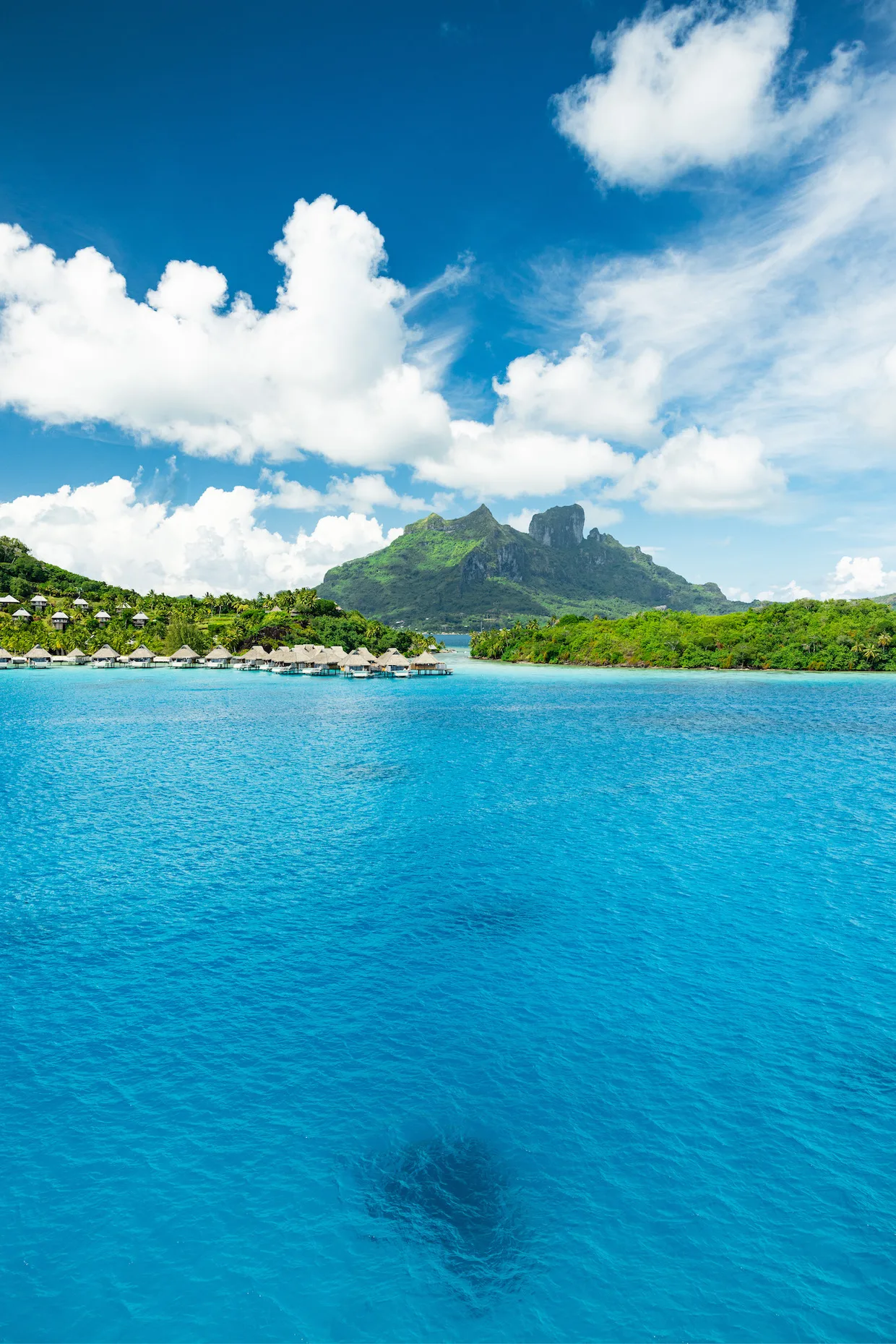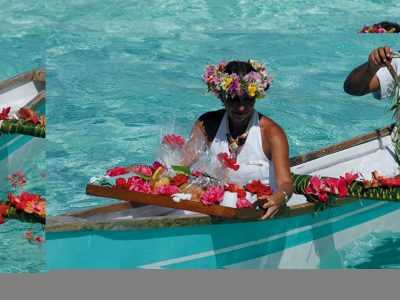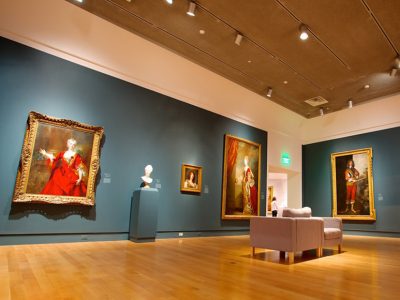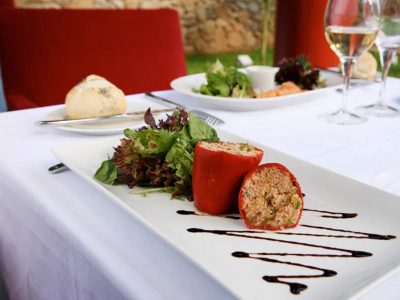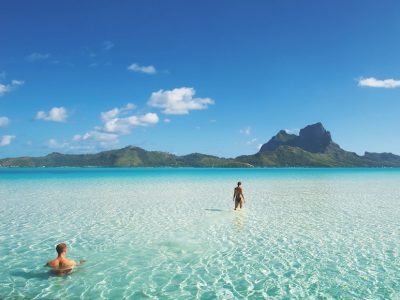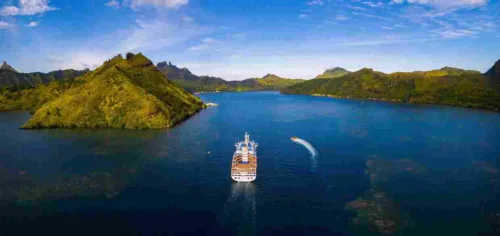Officially known as French Polynesia, The Islands of Tahiti are made up of 118 islands spread over four thousand square kilometres of ocean in the eastern South Pacific. The islands are further grouped into five archipelagos: the Society Islands, Austral Islands, Marquesas Islands, Tuamotu Islands and Gambier Islands.
Capital and major centres
Papeete is the capital of Tahiti, the largest island within French Polynesia, dubbed the Mother Island. The country’s only international airport, Faa’a is located on the island, making Tahiti the first stop in every itinerary. Moorea is Tahiti’s closest neighbouring island, some 17 kilometres north-west of Papeete. Heart-shaped Moorea is home to soaring volcanic peaks and magnificent views overlooking the tranquil waters of Cooks Bay and Opunohu Bay.
The Society Islands also include the legendary Bora Bora, 240 kilometres northwest of Tahiti, as well as Huahine, comprised of two islands joined by a narrow isthmus and enclosed by a protective necklace of coral.
Rangiroa and Tikehau are the best-known islands in the Tuamotu archipelago. Rangiroa is the largest atoll in the Tuamotus, encircling a 67-kilometre turquoise lagoon famed for its rich diversity of marine life.
Tikehau has an almost perfectly circular shape, with its many atolls surrounding a lagoon that extends 26 kilometres across.
Some other lesser-known islands worth exploring include every diver’s paradise Fakarava island, which has been declared a UNESCO Biosphere Reserve and is known for its incredible underwater world, the majestic islands in the Marquesas archipelago such as Nuku Hiva with its dramatic volcanic peaks and rugged landscape and Hiva Oa, which is the home of the largest tiki statues in French Polynesia. These lesser-known islands offer a very authentic look into the old Polynesia.
For an even more remote experience, travellers can explore islands such as Rurutu and Rimatara in the Austral Archipelago, which is often considered a very untouched and mysterious land and is one of the best places in the destination to swim with humpback whales.
The people
The population of The Islands of Tahiti is a multicultural mix of Polynesians of ma’ohi (Maori) extraction, Europeans and Asians. They are noted for their hospitality, friendliness and easy-going nature. French and Tahitian are the two official languages on the islands, however English is widely spoken in hotels and shops.
The Tahitians still today embody their rich and expressive culture from their ma’ohi ancestors, where music, dance and art of the past is very much part of Tahitians everyday life. The power of Mana is the sacred force of the Tahitian life and links all living things, past and present.
History
Hundreds of years after the ancient Polynesians made the Tahitian islands their home, explorers like Mendana, Quiros, Le Maire, Schouten, Roggeveen and Byron made brief and unplanned visits to the Tuamotu Islands and the Marquesas islands in the 16th, 17th and 18th centuries. Later in the 18th century explorers such as Bougainville, Wallis, Vancouver and Cook ‘discovered’ Tahiti and called it ‘La Nouvelle Cythère’.
Captain Cook returned three times to study the transition of Venus, Captain Bligh came to collect seedlings from the wondrous ‘Uru’ or breadfruit tree, and the insubordinate Fletcher Christian returned to the islands following the infamous mutiny on the Bounty.
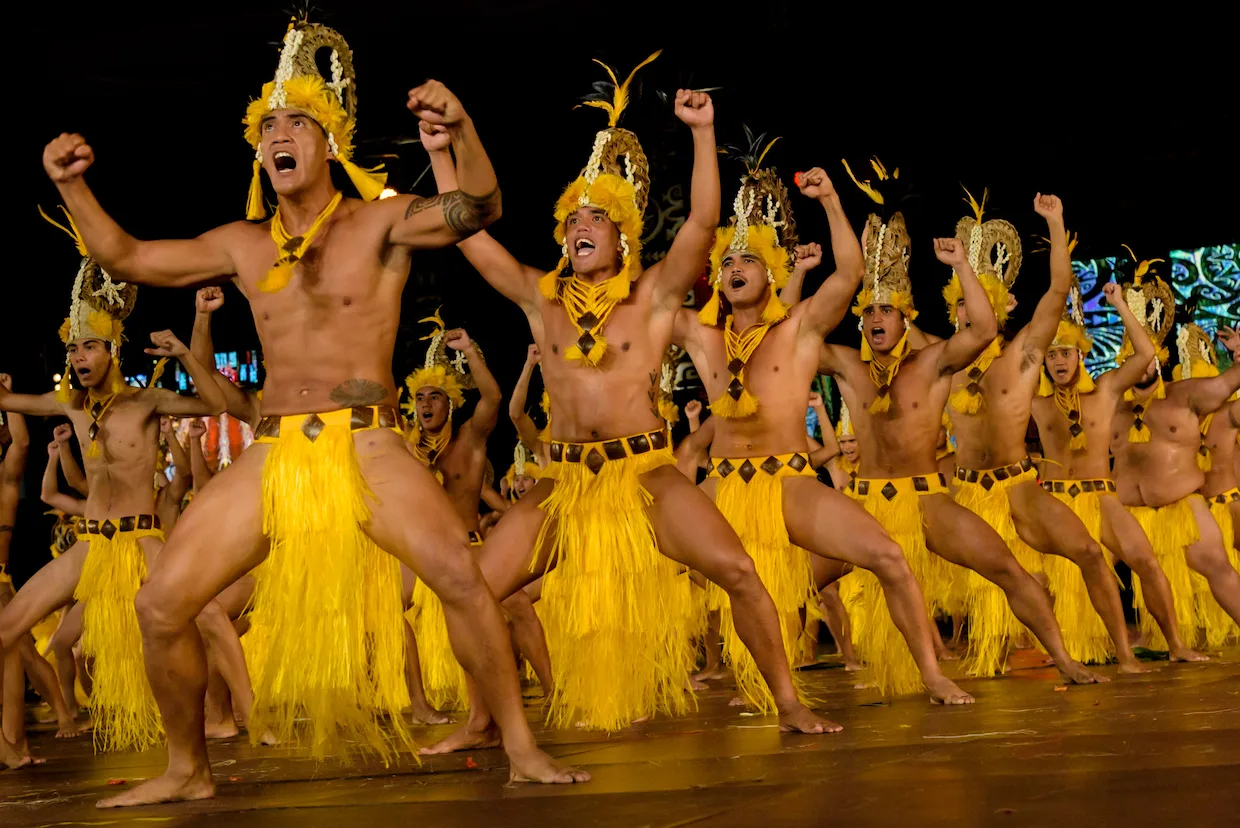
Before the arrival of the Europeans, the islands were divided into districts, each governed by a chief. When King Pomare V abdicated in 1880, The Islands of Tahiti, previously a protectorate of France, became a French colony, and in 1958 reconstituted as a French Overseas Territory and renamed French Polynesia. In 2004, French Polynesia became an Overseas Country withing the French Republic with self-governing powers and a mission to provide for her people through commerce and investment.
Nature
With its 118 islands spread across such a wide area, the islands consist of a mix of islands with dramatic high volcanic peaks and low-lying atolls. There’s a beautiful contrast between the lush vegetation growing high above the lagoons and bays and there’s a floral scent permeating the tropical air.
A myriad of tropical flowers grow throughout The Islands of Tahiti. The national flower is the tiare, a heavily scented gardenia that forms the basis of the traditional lei necklaces.
The sights
You can visit Point Venus where Captain Cook camped to observe the transit of the planet Venus in 1769, visit the Faaruma waterfalls, and at Taravao on the strategic isthmus joining Tahiti Nui and Tahiti Iti, wander through an old fort built by the French in 1844.
Don’t miss the Gauguin Museum in the Papeari district, set in exotic botanical gardens, and the wonderful fruit, vegetable and flower market in central Papeete.
Another noteworthy spot is the Mus̩e de Tahiti et des ̨les РTe Fare Manaha, which is a collection of important artefacts of the Polynesian culture and history.
Food and entertainment
Tahitian tamara’a’ or feasts can be arranged through local tour operators. The major international hotels often host evening programs with lavish buffets and dance shows featuring the performances of some of Tahiti’s most talented dancers and musicians. Outside the hotels, French, Italian and Chinese cuisine is widely available. There are a host of bars, cafes and nightclubs scattered around Papeete giving travellers a wide choice and a chance to mix with the locals. Dotted around the capital and down in the marina is a range of food trucks offering where you can try a wide selection of food the locals love.
Must-try dishes in The Islands of Tahiti include the national dish poisson cru, which is a mix of raw tuna marinated in lime juice and coconut milk, chicken fáfá with taro leaves and other dishes cooked in a traditional ahima’a (Polynesian underground oven).
Where to stay
International luxury resorts and hotels nestle alongside lodges on the islands. For an authentic Tahitian experience, many families also offer rooms for rent within their homes also referred to pensions or guesthouses. There are also youth hostels and campsites with cooking facilities for those on a tight budget. For larger groups or families, renting a vacation home is also a great alternative.
Getting around
Le Truck is Tahiti’s public bus service. The destination is posted on top of each Le Truck, which always begins and ends its round trips at the public market in the centre of Papeete. It is also possible to travel between islands by ferry, with the Aremiti ferry taking just 40 minutes from Papeete to Moorea.
Activities
Tahiti is renowned for its range of water sports, from diving and snorkelling, to windsurfing and sailing, to deep-sea fishing, surfing and jet-skiing. Speedboats are available for waterskiing and there are glass-bottom boats for viewing the coral reefs. Tennis and squash are on offer at many resorts and at the country club and Tahiti and Moorea offer championship golf courses.
For the more adventurous, there’s a range of bushwalking and hiking available on the volcanic islands of the Society Islands, as well as horse-riding.
Shopping guide
Bright pareus (Tahitian sarong) or T-shirts are popular souvenirs, as are Tahitian shell jewellery, the famous black pearls, French perfume and local handicrafts.
Climate
The French Polynesian islands enjoy a tropical climate. The average temperature is 27ºC, and the waters of the lagoons are a fairly constant 26ºC.
Clothing
Casual. Pareus are popular worn over swimming costumes to the beach or around the pool. Papeete is more cosmopolitan.
Electricity
Most hotels use 110 or 220 volts, AC 60 cycles.
Time zone
GMT10 hours. AEDT 20 hours. Two hours behind US Pacific Standard time and 21 hours behind Australia’s east coast. The Marquesas Islands are 30 minutes ahead of the rest of French Polynesia.
Currency
Central Pacific franc (XPF). Tipping is discretionary.
Visas and health
All passengers entering French Polynesia must have an outbound ticket. Check with airline as entry formalities may change.
There is no departure tax and Australians do not require visas. Other visitors, check with the French Consulate.
Getting there
Air France, Hawaiian Airlines, Air New Zealand, QANTAS, LanChile (via Easter Island), Air Caledonie International and Air Tahiti Nui. The domestic carrier is Air Tahiti.

